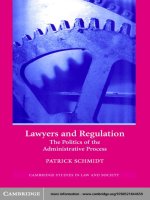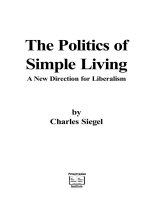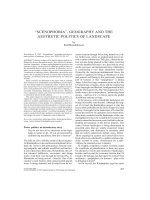THE POLITICS OF THE USA_SLIDE PowerPoint
Bạn đang xem bản rút gọn của tài liệu. Xem và tải ngay bản đầy đủ của tài liệu tại đây (1.28 MB, 28 trang )
1.
2.
3.
4.
5.
GROUP 4
LE THI THUY SANG
TRAN THI LE THAO
NGUYEN THI LAN
NGUYEN THI THUY
PHAM THI PHUONG DIEU
CHAPTER 5
POLITICS OF THE
U.S.A
5.1
The Institution and the Federal System
5.1.1. The Constitution
5.1.2. The Federal System
5.1.3. State government
5.1.4. Political parties
5.2
Choosing the Nation’s President
5.2.1. The Conventions
5.2.2. The Campaign
5.2.3. The election
5.1.1 THE CONSTITUTION
- The United States Constitution is the supreme law of the
United States. It was written in 1787 during the Philadelphia
convention. It’s based on the doctrine of the separation of
powers between the executive, legislative and judiciary.
- The Constitution, originally comprising seven articles,
delineates the national frame of government.
+ Its first three articles embody the doctrine of the separation
of powers, whereby the federal government is divided into three
branches: the legislative, consisting of the bicameral Congress;
the executive, consisting of the President; and the judicial,
consisting of the Supreme Court and other federal courts.
+Articles Four, Five and Six embody concepts of federalism,
describing the rights and responsibilities of state governments
and of the states in relationship to the federal government.
+ Article Seven establishes the procedure subsequently used
by the thirteen States to ratify it.
- It is regarded as the oldest written and codified national
constitution in force in the world.
-This Constitution is the basic law from which
the United States government gets all its power.
It is the law that protects those who live in the
United States from unreasonable actions by
national government or any state.
- June 21, 1988 was the 200th anniversary of
the adoption of the United States
Constitution. It is the oldest written
constitution still in use. Yet, since the
addition of the Bill or Rights in 1791, the
Constitution has been changed (amended)
only 16 times, and one of those amendment
simply canceled another.
- The Constitution defines three branches of
government: the legislative branch, which
enacts (makes) laws, the executive branch,
which enforces them, and the judicial branch,
which interprets them ( decides what they
mean)
Branches of the U.S. Government
The Constitution of the United States divides the federal government into
three branches to make sure no individual or group will have too much
power:
- Legislative—Makes laws (Congress—House of Representatives and Senate)
- Executive—Carries out laws (president, vice president, Cabinet, most federal
agencies)
- Judicial—Evaluates laws (Supreme Court and other courts)
Each branch of government can change acts of the other branches:
- The president can veto legislation created by Congress and nominates heads of
federal agencies.
- Congress confirms or rejects the president's nominees and can remove the president
from office in exceptional circumstances.
- The Justices of the Supreme Court, who can overturn unconstitutional laws, are
nominated by the president and confirmed by the Senate.
- This ability of each branch respond to the actions of the other branches is called the
system of checks and balances.
5.1.1.1 Legislative Branch
The legislative branch drafts proposed laws, confirms or rejects
presidential nominations for heads of federal agencies, federal judges,
and the Supreme Court, and has the authority to declare war. This branch
includes Congress (the Senate and House of Representatives) and specia
agencies and offices that provide support services to Congress. American
citizens have the right to vote for Senators and Representatives through
free, confidential ballots.
Senate—There are two elected Senators per state, totaling 100 Senators.
A Senate term is six years and there is no limit to the number of terms an
individual can serve.
House of Representatives—There are 435 elected Representatives, whic
are divided among the 50 states in proportion to their total population.
There are additional non-voting delegates who represent the District of
Columbia and the territories. A Representative serves a two-year term,
5.1.1.2 Executive Branch
The executive branch carries out and enforces laws. It includes the president, vice
president, the Cabinet, executive departments, independent agencies, and other
boards, commissions, and committees.
American citizens have the right to vote for the president and vice president through
free, confidential ballots.
Key roles of the executive branch include:
President—The president leads the country. He or she is the head of state, leader of
the federal government, and Commander in Chief of the United States Armed Forces.
The president serves a four-year term and can be elected no more than two times.
Vice president—The vice president supports the president. If the president is unable
to serve, the vice president becomes president. The vice president can be elected and
serve an unlimited number of four-year terms as vice president, even under a different
president.
The Cabinet—Cabinet members serve as advisors to the president. They include the
vice president, heads of executive departments, and other high-ranking government
officials. Cabinet members are nominated by the president and must be approved by a
simple majority of the Senate—51 votes if all 100 Senators vote.
5.1.1.3 Judicial Branch
- The judicial branch interprets the meaning of laws, applies laws to individual cases,
and decides if laws violate the Constitution. It's comprised of the Supreme Court and
other federal courts.
- Supreme Court—The Supreme Court is the highest court in the United States. The
Justices of the Supreme Court are nominated by the president and must be approved by
the Senate.
- Nine members make up the Supreme Court— a Chief Justice and eight Associate
Justices. There must be a minimum or quorum of six Justices to decide a case.
- If there is an even number of Justices and a case results in a tie, the lower court's
decision stands.
- There is no fixed term for Justices. They serve until their death, retirement, or
removal in exceptional circumstances.
- Federal Courts and Judicial Agencies – The Constitution gives Congress the authority
to establish other federal courts to handle cases that involve federal laws including tax
and bankruptcy, lawsuits involving U.S. and state governments or the Constitution, and
more. Other federal judicial agencies and programs support the courts and research
judicial policy.
Confirmation Process for Judges and Justices
Appointments for Supreme Court Justices and other federal judgeships follow the
same basic process:
- The president nominates a person to fill a vacant judgeship.
- The Senate Judiciary Committee holds a hearing on the nominee and votes on
whether to forward the nomination to the full Senate.
- If the nomination moves forward, the Senate can debate the nomination. Debate
must end before the Senate can vote on whether to confirm the nominee. A Senator
will request unanimous consent to end the debate, but any Senator can refuse.
- Without unanimous consent, the Senate must pass a cloture motion to end the
debate. It takes a simple majority of votes—51 if all 100 Senators vote—to pass
cloture and end debate about a federal judicial nominee.
- Once the debate ends, the Senate votes on confirmation. The nominee for Supreme
Court or any other federal judgeship needs a simple majority of votes—51 if all 100
Senators vote—to be confirmed.
- Probably the most significant portion of the Constitution is the
Bill of Right, the first 10 amendments to constitution
- The first of these assures freedom of religion, speech, and the
press and the right to complain to and about the government
- The fourth, fifth, sixth, and eighth Amendments protect people
suspected or accused of crimes. But they also protect the
ordinary person. Government official and police cannot arrest
people or search them, their property, or their homes without
some reason to believe that they have committed a crime
- The Fourteenth Amendment is one of the most valuable
protections that people living in the United States . The
Fourteenth Amendment has been interpreted by the Supreme
Court to apply almost all of the provisions in the Bill of Rights
to the states
5.1.2 THE FEDERAL SYSTEM
- The United States is organized as federal system.
- The power to govern is divided between the national (federal) government,
located in Washington, D.C ., and the state governments. Whatever laws are
passes by congress( federal laws) must be authorized somewhere in the
United States Constitution. That what is meant by the statement that the
United States government gets all of its powers from constitution
- The constitution divided government authority by giving the national
government certain specified powers, reserving all other powers to the state
or to the people.
+ State powers
- State powers are called reserved powers
- State may exercise any power not delegated to national government
reserved to the people or denied by the constitution
- As a result states regulate: public schools, local government, and licenses
for certain professions
- States are divided into smaller governmental units: cities, towns, villages,
and countries. These units have some legislative authority, which the
receive from the state, and they are responsible for control within their
boundaries
+ National powers
Three types of powers
• Expressed powers: are powers directly stated in the constitution
(ex: to declare war)
• Implied powers: are powers needed to carry out expressed powers
(ex: draft men into the service)
• Inherent powers: are powers the government has because it’s the
government (ex: diplomatic relation)
- The original purpose of a national central government was to
perform those task that could not be performed efficiently by each
state individually . Such things as dealing with foreign nations,
establishing a monetary system, and regulating commerce between
the states could be done better by a single national authority
- In the federal system there are 90 District Courts presided over by
a district judge, which hear criminal cases involving breaches of
federal law and civil cases on federal matters
5.1.3 State government
- State governments of the United States are institutional units in
the United States exercising some of the functions of government at
a level below that of the federal government. Each state's
government holds fiscal, legislative and executive authority over a
defined geographic territory. The United States comprises 50 states:
13 that were already part of the United States at the time the present
Constitution took effect in 1789, plus 37 that have been admitted
since by Congress as authorized under Article IV, Section 3 of the
Constitution.
While each state government within the United States holds legal and
administrative jurisdiction within its bounds, they are not sovereign in the
Westphalia sense in international law which says that each State has sovereignty
over its territory and domestic affairs, to the exclusion of all external powers, on
the principle of non-interference in another State's domestic affairs, and that each
State (no matter how large or small) is equal in international law. Additionally, the
member states of the United States do not possess international legal sovereignty,
meaning that they are not recognized by other sovereign States such as, for
example, France, Germany or the United Kingdom, nor do they possess full
interdependence sovereignty (a term popularized by international relations
professor Stephen D. Krasner), meaning that they cannot control movement of
persons across state borders. The idea of "dual sovereignty" or "separate
sovereigns" is derived from the 10th Amendment to the Constitution, which states
that "the powers not delegated to the United States by the Constitution, nor
prohibited by it to the States, are reserved to the States respectively, or to the
people. "Structured in accordance with state law (including state constitutions and
state statutes), state governments share the same structural model as the federal
system, with three branches of government—executive, legislative, and judicial.
The governments of the 13 states that formed the original Union under the
Constitution trace their roots back to the British royal charters which established
them. Most of the states admitted to the Union after the original 13 have been formed
from organized territories established and governed by Congress in accord with its
plenary power under Article IV, Section 3, Clause 2 of the Constitution. Six
subsequent states were never an organized territory of the federal government, or part
of one, before being admitted to the Union. Three were set off from an already
existing state: Kentucky (1792, from Virginia), Maine (1820, from Massachusetts),
and West Virginia (1863, from Virginia). Two were sovereign states at the time of
their admission: Texas (1845, previously the Republic of Texas), and Vermont (1791,
previously the Vermont Republic De facto). One was established from unorganized
territory: California (1850, from land ceded to the United States by Mexico in 1848
under the terms of the Treaty of Guadalupe Hidalgo).
5.1.4 POTITICAL PARTIES
Two-party system
Republican Party(1854)
Democratic Party(1824)
Minor American Parties
5.1.4 POTITICAL PARTIES
- In the United States, there have usually been two
main political parties. Since the 1860s, these two
main parties have been the Republican Party and the
Democratic Party.
- The Republican Party has the most seats in the
House of Representatives as well as a majority in the
senate.
- The three largest parties aside from the two main
political parties are the Libertarian Party (United
States), Green Party of the United States, and the
Constitution Party in respective order.
5.1.4.1 Republican Party
- The Republican Party is one of
the two major political parties in
the United States.
- Republicans: Conservative: Free
market, let wealth distribute
naturally.
- The red, white, and blue elephant is the traditional
mascot of the Republican Party.
5.1.4.2 Democratic Party
- Democrats: Liberal: Avoid having extremely rich and
extremely poor
Generally Democrats support:
Expanding spending on government programs
Spending on business, education, infrastructure, cleanenergy
Universal healthcare
Regulating business and the economy
- There have been 15 Democratic presidents, the most
recent being Barack Obama, who was President from
2009 to 2017.
- The symbol of the Democratic Party is
the Donkey. Since the election of 2000,
the color blue has become a symbol for
Democrats
DIFFERENCE BETTWEN REPUBLICAN AND DEMOCRAT
REPUBLICAN
•
•
•
•
•
•
Small government
Lower Taxes
National Security
Family Values
Free Market Capitalism
Pro- Life
DEMOCRAT
•
•
•
•
•
•
Large Government
Higher Taxes
Individual Right
Gay Right
Environmental Issues
Pro- Choice
5.1.4.3 Minor American Parties
There are several minor parties in the United States. None of
them has ever had any seats in the United States Congress.
• Libertarian Party - A libertarian and liberal party which has
around 411,250 registered voters as of March 2016. It is the
third party (politics) and promotes a non-interventionist
foreign policy and civil liberties.
• Green Party - A left-wing environmentalist party that
promotes social democracy and respect for diversity, peace
and non-violence.
• Constitution Party - A conservative party that promotes
American nationalism, Pale conservatism, Christianity, the
anti-abortion movement, and greater attention on the U.S.
Constitution. Has around 440,000 registered voters.
5.2 Choosing the Nation’s President
5.2.1 The conventions
- A United States presidential nominating convention is a political convention held
every four years in the United States by most of the political parties who will be
fielding nominees in the upcoming U.S. presidential election. The formal purpose
of such a convention is to select the party's nominee for President, as well as to
adopt a statement of party principles and goals known as the platform and adopt the
rules for the party's activities, including the presidential nominating process for the
next election cycle.
- In the modern U.S. presidential election process, voters participating in the
presidential primaries are actually helping to select many of the delegates to these
conventions, who then in turn are pledged to help a specific presidential candidate
get nominated. Other delegates to these conventions include political party
members who are seated automatically, and are called "unpledged delegates"
because they can choose for themselves for which candidate they vote.
5.2.2 The campaign
- A political campaign is an organized effort which seeks to influence the decision
making process within a specific group. In democracies, political campaigns often
refer to electoral campaigns, by which representatives are chosen or referendums
are decided. In modern politics, the most high-profile political campaigns are
focused on general elections and candidates for head of state or head of
government, often a president or prime minister.
- The message of the campaign contains the ideas that the candidate wants to share
with the voters. It is to get those who agree with their ideas to support them when
running for a political position. The message often consists of several talking
points about policy issues. The points summarize the main ideas of the campaign
and are repeated frequently in order to create a lasting impression with the voters.
In many elections, the opposition party will try to get the candidate "off message"
by bringing up policy or personal questions that are not related to the talking
points. Most campaigns prefer to keep the message broad in order to attract the
most potential voters. A message that is too narrow can alienate voters or slow the
candidate down with explaining details.









